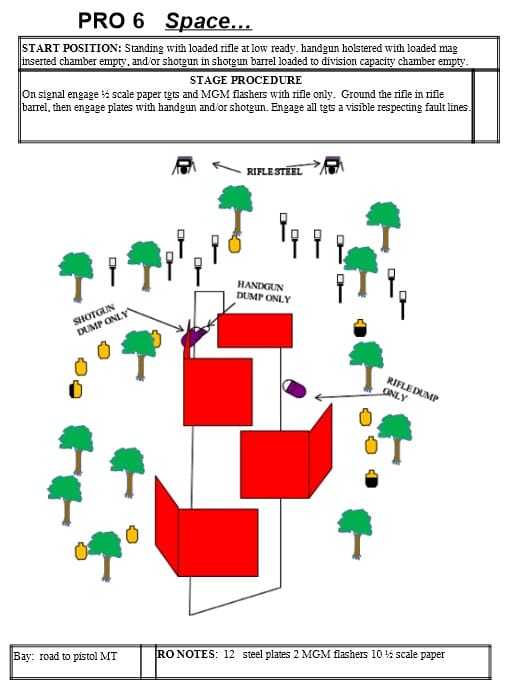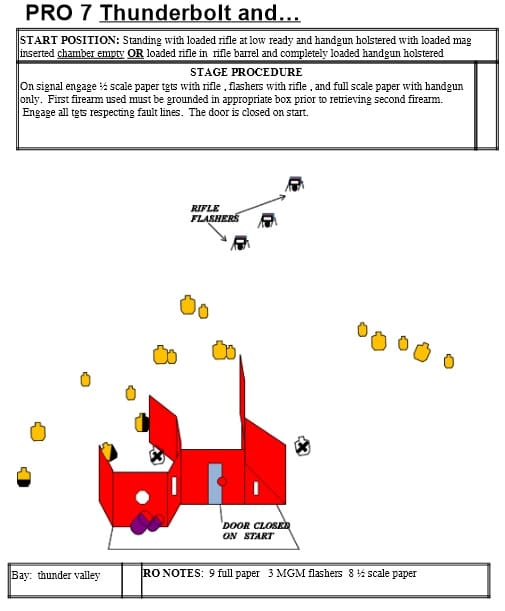For the final day of the competition, we only had two stages left. My chances of a good finish had already flown out the window, so all I was concerned with was not making any more drastic errors. Thankfully, the Gods of 3-gun were smiling down upon me as I stepped out onto the first stage of the day.
We started on stage 6, where there was an actual choice on how to shoot the stage. You started with the rifle and engaged some paper plates along with some long range rifle targets, and then you needed to knock over about 8 steel plates (again, next to no-shoot targets).
The option was in the steel plates, you could shoot them with either a handgun or a shotgun. The benefit of the shotgun option was that you could probably hit the targets faster, but it was possible that you could hit the no-shoot with your shot pattern and you only had 8 rounds and might need to reload. The handgun was the preferred method of shooting the stage, especially since the targets were so big and so close.
When I ran the stage, I had a small problem with the paper targets. They were set up behind some barriers, so you couldn’t see all of the targets from a single position. It added a “memory” aspect to the stage, remembering where to shoot what targets. I don’t do very well on memory stages, and with the end of the competition so close I didn’t want to take any chances. So I shot every single target I saw, probably perforating a few targets 4+ times. That added a good 5 seconds to my time, which on these quick stages is an eternity.
The one thing that Eric Lund dinged me on was that as soon as I got to the end of the stage, I rested my rifle on a barricade for some close-range paper targets instead of shooting them freehand. I had planned to shoot the longer range steel targets from that position (others had gone to a kneeling position or even prone to hit those targets, but I thought leaning against the barricade would be quicker) but I had gotten into position a little sooner than planned. As Eric pointed out, by resting on that barricade I made it more difficult to transition from one target to the next and probably slowed me down.
Everything else about the stage went perfectly. I once again traded Larry for the prototype FNS-9 Competition, and went almost one-for-one on the steel plates. Nevertheless, I still need a ton more practice with the handgun to get anywhere close to proficient.
The final stage of the competition for us was stage 7, and once again there was actually a choice about how to shoot the stage. The stage brief called for a rifle and a handgun, and the shooter could start with either one.
The stage included a window that needed to be opened to reveal an array of targets on one side of the course, a long range rifle section and some paper targets on the other side, and a slim window in the middle with some handgun targets. Shooters could start with whatever firearm they want, and could start from anywhere within the fault lines of the stage.
The pro shooters were split on how to shoot the stage. Shooters like Tommy Thacker and Eric Lund started with the handgun, and the reason is the window that they need to open. There are two additional targets off to the right of the stage, and they figured that the quickest way to shoot the stage was to engage those side targets while waiting for the door to open up on that window and then engage the targets within.
My trick to opening ports like this one, where the handle is a relatively small object and difficult to grip in a hurry, is to grab the top of the window instead. It’s a larger target, easier to find and use under pressure, and gives me more leverage to open the thing up. It doesn’t always work depending on how the port is designed, but when possible that’s my preferred method. One of the benefits of being a tall guy.
I took the opposite approach, and the reason is the long range rifle targets. If you start with the handgun, then by the time you’re back on the rifle you are huffing and puffing and your heart rate is through the roof making long range accuracy difficult. By starting with the rifle, I could make those long range shots without any trouble and then move on to the rest of the stage. Even better, I could take those rifle targets while standing, as the shooters that started with the handgun needed to drop into a prone position to steady themselves enough. Dropping to the prone position meant that they lost time getting into position, and couldn’t pivot from one target to the next as fast as possible.
This stage went perfectly for me. I had been joking with Jayson Smith (another shooter on the FNH USA team) all competition long about which one of us would walk away with the higher score, and my run on this stage was the final nail in that coffin. I finished only 25% behind Larry Houck, running the stage in 50 seconds compared to his 40 seconds, which is a pretty stark improvement over where I was at the beginning of the year (running 100% behind, double his time on just about everything). Jayson came up to me after the stage was over and jokingly complained that I was supposed to self-destruct on the last stage, not smoke it.
My final score for the weekend was 144th place, almost exactly the middle of the “Pro” shooters TacOps division. I was well above average in terms of my final time, but the distribution of shooter’s times isn’t exactly “normal” — it’s a “long tail” sort of distribution, with a very few really slow times throwing off the average. I thought that I was on track to break the top 100, but that just wasn’t in the cards this weekend. Hopefully I’ll be able to get in some handgun practice before the next competition and bring my scores up.






Nice shooting sir!
What brand is that camera Nick wears on his head?
These videos are fun to watch.
Nick is a man of many cameras, but I’m pretty sure that’s a GoPro.
Keep up the progress Nick. One thing, if attitude means anything, trying to ‘minimize errors’ is a mindset that always leads to “almost exactly the middle “. The way to improve in almost everything is like in the card game Hearts, try to run them every time. The worst that happens is you ‘eat the bitch’, but usually, you get better, fast.
That definitely looks fun.
Dang, that does look like fun. And you say you’re not really proficient with the pistol? If I shot a sequence like you did on the first stage in this video, I’d treasure the memory for the rest of my life.
Hey Nick,
Thanks for posting these, they are great to watch, and I love to watch the video, then read your diagnosis of the stage.
One thing that I noticed on both the second and the third video is that you huff and puff…a lot. I do to, but a trick that I learned is called diaphram breathing, its where you pop your belly out and in to breath rather than breath with your shoulders going up and down, this helps not only to create a stable platform, but it is more effective breathing. By popping your belly out you creat a vaccuum which has to be filled with air, it take no effort only a little bit of training. I also noticed that you hold your breathe during the shotgun and pistol portions, breathing through your diaphram will not disturb your sight picture during these portions of the stage and will allow your body to recover a little from your running.
Hope this helps.
Comments are closed.